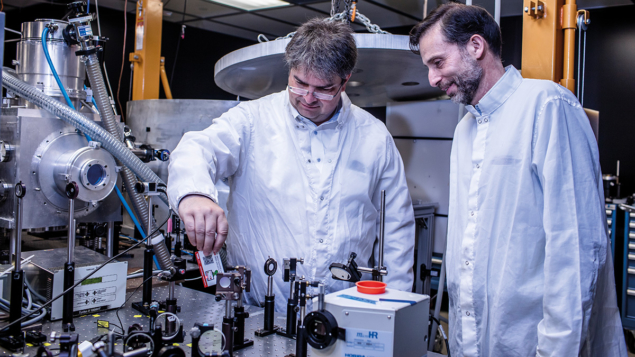Newly established US firm TAU Systems aims to commercialise laser-plasma wakefield accelerators for applications ranging from medical imaging to advanced light sources.

In 1997, physics undergraduate Manuel Hegelich attended a lecture by a visiting professor that would change the course of his career. A new generation of ultra-short-pulse lasers had opened the possibility to accelerate particles to high energies using high-power lasers, a concept first developed in the late 1970s. “It completely captured my passion,” says Hegelich. “I understood the incredible promise for research and industrial advancement if we could make this technology accessible to the masses.”
Twenty-five years later, Hegelich founded TAU Systems to do just that. In September the US-based firm secured a $15 million investment to build a commercial laser-driven particle accelerator. The target application is X-ray free-electron lasers (XFELs), only a handful of which exist worldwide due to the need for large radio-frequency linacs to accelerate electrons. Laser-driven acceleration could drastically reduce the size and cost of XFELs, says Hegelich, and offers many other applications such as medical imaging.
Beam time
“As a commercial customer it is difficult to get time on the European XFEL at DESY or the LCLS at SLAC, but these are absolutely fantastic machines that show you biological and chemical interactions that you can’t see in any other way,” he explains. “TAU Systems’ business model is two-pronged: we will offer beam time, data acquisition and analysis as a full-service supplier as well as complete laser-driven accelerators and XFEL systems for sale to, among others, pharma and biotech, battery and solar technology, and other material-science-driven markets.”
Laser-driven accelerators begin by firing an intense laser pulse at a gas target to excite plasma waves, upon which charged particles can “surf” and gain energy. Researchers worldwide have been pursuing the idea for more than two decades, demonstrating impressive accelerating gradients. CERN’s AWAKE experiment, meanwhile, is exploring the use of proton-driven plasmas that would enable even greater gradients. The challenge is to be able to extract a stable and reliable beam that is useful for applications.
Hegelich began studying the interaction between ultra-intense electromagnetic fields and matter during his PhD at Ludwig Maximilian University in Munich. In 2002 he went to Los Alamos National Laboratory where he ended up leading their laser-acceleration group. A decade later, the University of Texas at Austin invited him to head up a group there. Hegelich has been on unpaid leave of absence since last year to focus on his company, which currently numbers 14 employees and rising. “We have got to a point where we think we can make a product rather than an experiment,” he explains.
The breakthrough was to inject the gas target with nanoparticles with the right properties at the right time, so as to seed the wakefield sooner and thus enable a larger portion of the wave to be exploited. The resulting electron beam contains so much charge that it drives its own wave, capable of accelerating electrons to 10 GeV over a distance of just 10 cm, explains Hegelich. “The whole community has been chasing 10 GeV for a very long time, because if you ever wanted to build a big collider, or drive an XFEL, you’d need to put together 10 GeV acceleration stages. While gains were theorised, we saw something that was so much more powerful than what we were hoping for. Sometimes it’s better to be lucky than to be good!”
The breakthrough was to inject the gas target with nanoparticles with the right properties at the right time
Hegelich says he was also lucky to attract an investor, German internet entrepreneur Lukasz Gadowski, so soon after he started looking last summer. “This is hardware development: it takes a lot of capital just to get going. Lukasz and I met by accident when I was consulting on a totally different topic. He has invested $15 million and is very interested in the technical side.”
TAU Systems (the name comes from the symbol used for the laser pulse duration) aims to offer its first products for sale in 2024, have an XFEL service centre operational by 2026 and start selling full XFEL systems by 2027. Improving beam stability will remain the short-term focus, says Hegelich. “At Texas we have a laser system that shoots once per hour or so, with no feedback loop, so sometimes you get a great shot and most of the time you don’t. But we have done some experiments in other regimes with smaller lasers, and other groups have done remarkable work here and shown that it is possible to run for three days straight. Now that we have this company, I can hire actual engineers and programmers – a luxury I simply didn’t have as a university professor.”
He also doesn’t rule out more fundamental applications such as high-energy physics. “I am not going to say that we will replace a collider with a laser, although if things take off and if there is a multibillion-dollar project, then you never know.”








